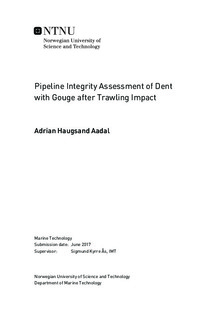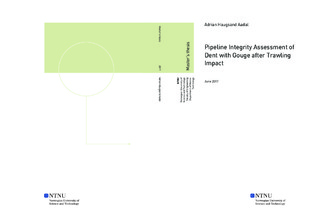| dc.description.abstract | Damage to pipelines from interaction with trawler-gear affects the long-term integrity of the pipeline, and interference from trawling-equipment on subsea pipelines is a relatively common occurrence. This thesis looks on how a gouge introduced to a dent in the pipe affects the fatigue life, compared to a dent without a gouge. The indentation from trawler-gear is replicated by a test-rig and simulated numerically.
A damage system with a smooth dent containing a gouge is a severe form of mechanical damage on a pipeline, and pipes containing dent with gouge must be replaced according to today's regulations. A brief review of the current practice of pipe damage assessment is done, with methodologies from PETROBRAS, The European Pipeline Research Group and American Petroleum Institute, among others.
The numerical model was made to resemble the conditions of the experimental test-setup to create comparable results. The setup allows denting of small scale pipes, creating dents with or without gouges. An indenter is pushed along the top of the pipe transverse to the pipe longitudinal-axis, resembling trawler-equipment impact. The pipe is first subjected to an incrementally increasing static pressure. The pipe is then subjected to internal pressure cycles with fixed mean and amplitude pressure. The dent geometry is not equal for the experimental and numerical results, and the dent behaves differently under pressure because of different material properties. This makes the comparison more complicated, but the residual stresses from an x-ray diffractor gives good consistent results with the numerical simulation.
A total of ten fatigue tests are carried out for dents with and without a gouge. Assuming a maximum fatigue life of 1.000.000 pressure cycles, the endurance limit decreases from 44 bar to 36 bar when introducing a gouge, a factor of 18.2%. This decrease is not as severe as expected in terms of fatigue life. The most critical areas are where the indenter enters and exits the pipe for high pressure, and on the side of the dent shoulder for low pressure. The dents with gouge have the through-crack initiated from the gouge base, which decreases the fatigue life.
Fatigue life is influenced by stress concentrations, which in turn are influenced by the dent geometry. Rerounding of the dent from internal pressure reduces the dent depth, which reduces the stress concentrations. In this thesis, one test is performed with increased rerounding before the fatigue test begins. This more than doubled the number of cycles of the pipe without failing, compared to a similar pipe with no increased rerounding. This indicates that it could be a potential way of repairing dents in term of a fatigue perspective.
This thesis only uses pipes with one geometry, creating dents with one depth. More fatigue tests should be performed to improve the knowledge on the effect of a gouge in the dent. This thesis only investigates possibilities, and could serve as a preliminary study for future fatigue tests. | |

